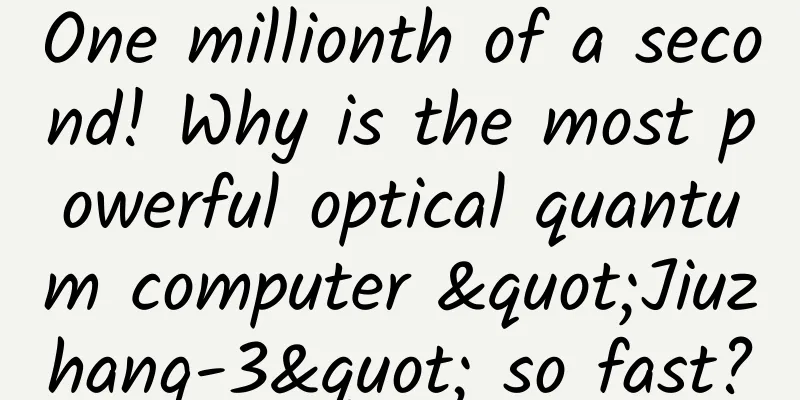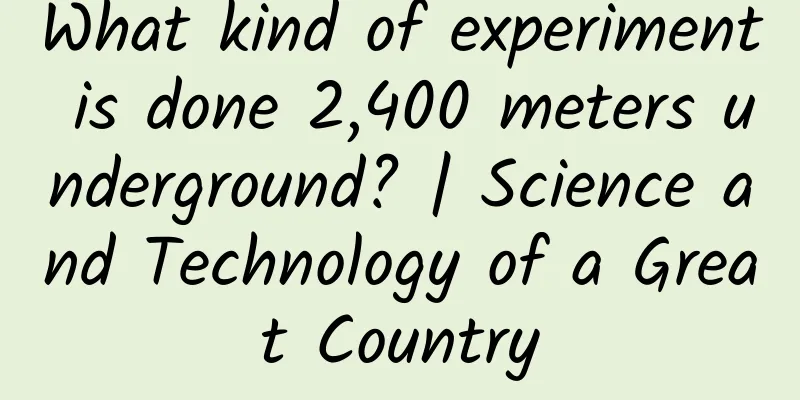One millionth of a second! Why is the most powerful optical quantum computer "Jiuzhang-3" so fast?

|
Produced by: Science Popularization China Author: Luan Chunyang (Department of Physics, Tsinghua University) Producer: China Science Expo On October 11, 2023, the internationally renowned physics academic journal Physical Review Letters published the latest research results of a Chinese research team in the field of optical quantum computing . The optical quantum computing research team composed of Pan Jianwei, Lu Chaoyang, Liu Naile and others from the Institute of Quantum Information and Quantum Technology Innovation of the Chinese Academy of Sciences at the University of Science and Technology of China, in collaboration with the Shanghai Institute of Microsystem and Information Technology of the Chinese Academy of Sciences and the National Parallel Computer Engineering Technology Research Center, successfully built the "Jiuzhang-3" optical quantum computing prototype with 255 photons , once again breaking the world record for the number of controllable photons in an optical quantum computer. The cover of the journal Physical Review Letters with “Jiuzhang-3” (Image source: Physical Review Letters website) "Jiuzhang-3" is the latest model that has been further developed and matured based on the previous "Jiuzhang" series of optical quantum computing prototypes. It represents the highest technological level in the current field of optical quantum computing . The research results show that compared with the previous "Jiuzhang No. 2" quantum computing prototype with the ability to manipulate only 113 photons, the "Jiuzhang No. 3" with 255 photons has a computing speed about one million times faster in processing the specific complex problem of " Gaussian boson sampling ". Therefore, "Jiuzhang-3" not only improves the ability of optical quantum computers to solve complex problems, but also creates the latest world record for quantum computing superiority, providing solid technical support for the ultimate development of a truly practical general-purpose quantum computer. Quantum computing concept map (Photo source: veer photo gallery) So, what exactly is a photon? How does a photon participate in computing to form a photon quantum computer? Why did scientists choose the complex problem of "Gaussian boson sampling" to solve the computation? How far is the current "Jiuzhang" series of quantum computing prototypes from truly practical universal quantum computers? The “ photon ” that is both familiar and unfamiliar Light quanta, also known as photons, can transmit electromagnetic interactions at the speed of light . They were first proposed by Albert Einstein in 1905 and officially named by American scientist Gilbert Lewis in 1926. In the macroscopic world we live in, light is one of the most familiar things to people, and has developed mature branches of physics such as geometric optics. In junior high school physics class, we learned about the reflection and refraction of light, which shows that light has particle properties similar to tiny particles; in high school physics class, we further learned that light can also interfere and diffract, which shows that light is an electromagnetic wave and therefore has wave properties similar to sound waves or water waves . That is to say, from the perspective of the macroscopic world we live in , light is a whole composed of an extremely large number of photons, and this whole has both particle and wave properties, which is also called the "wave-particle duality" of light. Light in the macroscopic world (Photo source: veer photo gallery) However, from the perspective of the microscopic world , each photon has neither pure wave properties like sound waves or water waves in the macroscopic world, nor pure particle properties like extremely small atoms or molecules, but needs to be described by quantization in quantum mechanics. Quantization means that the energy of matter in the microscopic world can only change discontinuously in the smallest energy unit (quantum). For photons, each photon is the smallest unit that constitutes light in the macroscopic world, and the energy of light is also composed of photon energy one by one . Conceptual diagram of photons in the microscopic world (Photo source: veer photo gallery) Then why does light in the macroscopic world we live in always feel stable and continuous rather than changing bit by bit? This is because the energy of each photon is extremely small, about 5×10^19. J. In comparison, the flash power on our ordinary smartphones is about 1W, which means that the flash on the phone can emit about 2×10^18 photons in just 1 second. Therefore, it is difficult to feel the existence and changes of photons in the macroscopic world we live in . Photonic quantum computing: a future technology with unlimited potential So how do photons participate in computing to form optical quantum computers? This starts with quantum computers. In today's life, the electronic devices such as computers and calculators we use still belong to the category of classical computers. As the computing power of classical computers continues to approach the limit of Moore's Law, simply increasing the number of processors in classical computers will become increasingly difficult to adapt to the huge data computing needs of the future. Quantum computers are different from classical computers. They use the parallel computing characteristics of quantum mechanics theory to have more efficient computing performance. Quantum computers use quantum bits as basic computing units, and each quantum bit can be in a superposition of state 0 and state 1 , rather than a classical bit in a classical computer that can only be in state 0 or state 1. For example, each quantum bit can be in state 0 with probability P and in state 1 with probability Q, and it is sufficient to keep the sum of probabilities P and Q equal to 1. Schematic diagram of the encoding of optical quantum bits (Photo source: veer photo gallery) It is the unique superposition of quantum bits that allows quantum computers to process complex computing problems in parallel. For example, a quantum computer with N quantum bits can process 2 ^N data in parallel, thus demonstrating exponentially high computing power on certain specific problems. Therefore, the question of how to build a truly practical quantum computer has received widespread attention from academia and industry, and optical quantum computing is one of the most promising research areas. Optical quantum computing is to encode the information of quantum bits into the degrees of freedom of each photon . The degrees of freedom of photons include polarization, angular momentum, etc. (Here we don’t need to pay too much attention to the more detailed physical concepts of photon degrees of freedom. We just need to understand that each photon can be constructed into a quantum bit through a specific encoding method.) In specific experiments, scientists also need to use various optical elements and carefully designed optical paths to complete the interaction between optical qubits, so as to realize the operation of qubit gates in the quantum computing process. However, the energy of a single photon is too weak, which makes it difficult to obtain a single photon in the experiment, and it is also difficult to detect the weak signal of a single photon. Schematic diagram of optical experiment (Photo source: veer photo gallery) Therefore, for optical quantum computing solutions, if we want to truly unleash the super computing power of optical quantum computers, we must not only solve the many technical problems we face one by one, but also further increase the number of controllable optical quantum bits , so as to make technical preparations for the ultimate construction of a practical quantum computer. "Jiuzhang" series: repeatedly achieving outstanding results in optical quantum computing At present, the solutions that are expected to realize universal quantum computers mainly include: superconducting quantum computing, ion trap quantum computing, optical quantum computing, etc. Among them, optical quantum computers have some unique advantages. First, optical quantum computers can work normally at room temperature, avoiding the requirement of low-temperature environment; second, photons are difficult to interact with noise in the environment, so they have good noise resistance; finally, with the continuous improvement of optical experimental technology, more compact and miniaturized optical quantum computing systems are expected to be realized in the future. The research team from the University of Science and Technology of China has been focusing on optical quantum computing systems and continuously improving the overall performance of optical quantum computing solutions. Among them, they chose the specific complex problem of Gaussian boson sampling to verify the quantum superiority of optical quantum computing. (Here, we don’t need to specifically study Gaussian boson sampling in depth, we just need to know that this specific problem is particularly suitable for parallel accelerated quantum computing by optical quantum computers.) As early as 2020, the optical quantum computing research team of the University of Science and Technology of China successfully developed the "Jiuzhang" optical quantum computing prototype with 76 photons . The research results show that the "Jiuzhang" optical quantum computing prototype is one hundred trillion times faster than the world's fastest classical supercomputer "Fugaku" at the time in processing specific problems of Gaussian boson sampling, and it is the first time in the world to verify quantum superiority in the field of optical quantum computing. Diagram of the experimental setup of the Jiuzhang optical quantum computing prototype (Image source: Reference [4]) In 2021, the team further upgraded the Jiuzhang prototype to the Jiuzhang-2 optical quantum computer with 1 13 photons . For the specific problem of Gaussian boson sampling, the processing speed of Jiuzhang-2 is nearly 10 billion times faster than Jiuzhang. Compared with the world's most powerful classical supercomputer at the time, the computing speed of Jiuzhang-2 is nearly 100 million billion (10 to the 24th power) times faster, further consolidating the quantum superiority in the field of optical quantum computing. Photo of the Jiuzhang-2 optical quantum computer experiment (Image source: Reference [5]) The latest "Jiuzhang-3" optical quantum computer has the ability to manipulate 255 photons , and its ability to solve the specific complex problem of Gaussian boson sampling is nearly one million times higher than that of the previous generation "Jiuzhang-2". The research results show that the complex calculation problem that Jiuzhang-3 completed in one millionth of a second would take more than 20 billion years to complete using the most powerful classical supercomputer, Frontier . This breakthrough not only reaffirms the superiority of quantum computing, but also further consolidates the international leading position of the Chinese research team in the field of optical quantum computing. Light path design diagram of the Jiuzhang-3 optical quantum computer (Image source: Reference [6]) Conclusion In summary, the optical quantum computing research team from China has been focusing on improving the overall performance of optical quantum computing, and has continuously created remarkable achievements in the cutting-edge topic of verifying quantum supremacy. The continuous breakthroughs from "Jiuzhang" to "Jiuzhang-2" and then to "Jiuzhang-3" show that the optical quantum technology prototype has powerful computing power that is difficult for classical computers to achieve in solving certain specific complex problems. In the past two decades, the world's optical quantum computing research team has set a record for the number of controllable photons. (Image source: Department of Quantum Physics and Quantum Information, University of Science and Technology of China) However, we also need to be aware that verifying quantum supremacy is a long-term and complex frontier issue that requires scientists to continuously explore and solve various core technical problems. We also need to continue to move towards the truly practical quantum computers of the future. We also firmly believe that in the near future, the dream of quantum computing will surely illuminate our reality. References [1] Chapter 9: Han-Sen Zhong et al., Quantum computational advantage using photons. Science 370, 1460-1463 (2020). DOI: 10.1126/science.abe8770 [2] Chapter 9 No. 2: Zhong, Han-Sen et al, Phase-Programmable Gaussian Boson Sampling Using Stimulated Squeezed Light[J]. Phys. Rev. Lett, 2021,127, 180502. [3] Chapter 9 No. 3: Deng, Yu-Hao et al, Gaussian Boson Sampling with Pseudo-Photon-Number-Resolving Detectors and Quantum Computational Advantage[J]. Phys. Rev. Lett, 2023, 131, 150601. [4] Zhong HS, Wang H, Deng YH, et al. Quantum computational advantage using photons[J]. Science, 2020, 370(6523): 1460-1463. [5] Zhong HS, Deng YH, Qin J, et al. Phase-programmable gaussian boson sampling using stimulated squeezed light[J]. Physical review letters, 2021, 127(18): 180502. [6] Deng, Yu-Hao et al, Gaussian Boson Sampling with Pseudo-Photon-Number-Resolving Detectors and Quantum Computational Advantage.[J]. PhysRevLett, 2023, 131.150601. |
Recommend
Wuhan high-end tea sn, reliable sea selection factory, highly recommended by veteran drivers
Wuhan high-end tea drinking the best audition ven...
What is the significance of Alibaba Pictures’ efforts to create Internet + movies?
Since Alibaba Ventures acquired a stake in Huayi ...
If these scenes cannot be connected, O2O will not have a perfect ending
[[158286]] The title of CEO has changed from a sy...
Analysis of the competition between TikTok and Tencent Weishi
Short videos have become an important part of peo...
Two or three things you don’t know about new energy vehicles
Will new energy vehicles be the ultimate trend of...
The latest distribution of Android versions: Android Oreo has reached 4.6%
Google has released data on the distribution of t...
Let's take a look at what happened to the new energy vehicle companies that were named by the Ministry of Industry and Information Technology as fraudulent subsidies
July 1st is a landmark day for the Chinese people...
Switching between HStack and VStack in SwiftUI
Preface SwiftUI’s various stacks are the most bas...
Marketing promotion: How are brainwashing advertisements made?
The main reason why brainwashing advertisements c...
Beyondsoft Global Headquarters Building Completed
On October 16, 2014, Beyondsoft, Asia's leadi...
Nexus and compact cameras couldn't save HTC from rapid decline
HTC released a number of new products in New York...
3 tips for landing page optimization!
The landing page is the most important part of th...
How to create a new brand from 0 to 1?
The scientific spirit can help us find relative c...
APP operation and promotion tips: 37 free online promotion channels
The following is a complete guide that will intro...
10 minutes to understand the optimization techniques of information flow advertising copy
In early February, Facebook released its full-yea...









